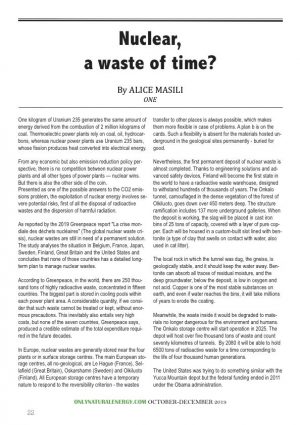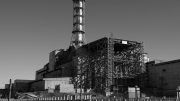 One kilogram of Uranium 235 generates the same amount of energy derived from the combustion of 2 million kilograms of coal. Thermoelectric power plants rely on coal, oil, hydrocarbons, whereas nuclear power plants use Uranium 235 bars, whose fission produces heat converted into electrical energy.
One kilogram of Uranium 235 generates the same amount of energy derived from the combustion of 2 million kilograms of coal. Thermoelectric power plants rely on coal, oil, hydrocarbons, whereas nuclear power plants use Uranium 235 bars, whose fission produces heat converted into electrical energy.
From any economic but also emission reduction policy perspective, there is no competition between nuclear power plants and all other types of power plants — nuclear wins. But there is also the other side of the coin. Presented as one of the possible answers to the CO2 emissions problem, the exploitation of nuclear energy involves severe potential risks, first of all the disposal of radioactive wastes and the dispersion of harmful radiation.
As reported by the 2019 Greenpeace report La crise mondiale des déchets nucléaires (The global nuclear waste crisis), nuclear wastes are still in need of a permanent solution. The study analyses the situation in Belgium, France, Japan, Sweden, Finland, Great Britain and the United States and concludes that none of those countries has a detailed long-term plan to manage nuclear wastes.
According to Greenpeace, in the world, there are 250 thousand tons of highly radioactive waste, concentrated in fifteen countries. The biggest part is stored in cooling pools within each power plant area. A considerable quantity, if we consider that such waste cannot be treated or kept, without enormous precautions. This inevitably also entails very high costs, but none of the seven countries, Greenpeace says, produced a credible estimate of the total expenditure required in the future decades.
In Europe, nuclear wastes are generally stored near the four plants or in surface storage centres. The main European storage centres, all no-geological, are Le Hague (France), Sellafield (Great Britain), Oskarshamn (Sweden) and Olkiluoto (Finland). All European storage centres have a temporary nature to respond to the reversibility criterion – the wastes transfer to other places is always possible, which makes them more flexible in case of problems. A plan b is on the cards. Such a flexibility is absent for the materials hosted underground in the geological sites permanently – buried for good.
Nevertheless, the first permanent deposit of nuclear waste is almost completed. Thanks to engineering solutions and advanced safety devices, Finland will become the first state in the world to have a radioactive waste warehouse, designed to withstand hundreds of thousands of years. The Onkalo tunnel, camouflaged in the dense vegetation of the forest of Olkiluoto, goes down over 450 meters deep. The structure ramification includes 137 more underground galleries. When the deposit is working, the slag will be placed in cast iron bins of 25 tons of capacity, covered with a layer of pure copper. Each will be housed in a custom-built slot lined with bentonite (a type of clay that swells on contact with water, also used in cat litter).
The local rock in which the tunnel was dug, the gneiss, is geologically stable, and it should keep the water away. Bentonite can absorb all traces of residual moisture, and the deep groundwater, below the deposit, is low in oxygen and not acid. Copper is one of the most stable substances on earth, and even if water reaches the bins, it will take millions of years to erode the coating.
Meanwhile, the waste inside it would be degraded to materials no longer dangerous for the environment and humans. The Onkalo storage centre will start operation in 2025. The depot will host over five thousand tons of waste and count seventy kilometres of tunnels. By 2080 it will be able to hold 6500 tons of radioactive waste for a time corresponding to the life of four thousand human generations.
The United States was trying to do something similar with the Yucca Mountain depot but the federal funding ended in 2011 under the Obama administration.
In the Trump administration’s view, it still makes sense to have a central repository. “But it is difficult to imagine that the shipment of over 5,000 barrels of high-level nuclear waste trucks over 50 years does not involve at least one radiological release,” Nevada Democratic Senator Jacky Rosen said.
Yucca Mountain is near the most extensive munition Air force testing area, which increases doubt and fears. In the end, the U.S. House Appropriations Committee discussed the issue and decided not to fund the Yucca Mountain project again. However, the Senate is still considering it, and both supporters and opponents claim that the fight is not over yet.
In the USA, the WIPP (Waste Isolation Pilot Plant), a pilot plant for the disposal of long-life plutoniferous waste produced in the centres of the federal government (the so-called defense wastes) is in operation since May 1999. The WIPP is the first and only deposit of geological disposal in the world, even if its aims are particular and it is not intended for high activity radioactive waste of classic type and commercial origin (vitrified waste or irradiated fuel).
Underground experimental laboratories are under construction or in operation in France, Germany, and Sweden.
While waiting for a geological disposal site to be available, radioactive wastes with a long-term condition are still kept in plant systems suitable for a few decades storage.
The Chernobyl disaster in 1986, which had lethal consequences for humanity, flora and fauna, irreversibly shook confidence in atomic energy and showcased its limits and weaknesses.
Chernobyl is still a focus of world attention. Recently, to verify the situation of the area, few drones were sent to inspect more than 15 km of territory.
Each drone was provided with a gamma-ray spectrometer, in conjunction with a precision Lidar. The results were alarming: no one thought that after decades, the situation was still so out of control and dangerous. The area around the reactor has been uninhabited for thirty years due to radiation, and it will continue to be so in the next decades due to the high level of contamination.
The nearby town of Prypyat has been deserted since 1986 and, as documented in various photo shoots, nature has slowly transformed the area, with creepers and trees that have returned to grow between the cracks of cement and asphalt. Last July, the new shield of the reactor number 4 was inaugurated due to the collapse of the old protective shell. A special project financed by the European Bank for Reconstruction and Development and sponsored by 45 countries. Even the concrete dome of the Marshall Islands in the Pacific Ocean is beginning to show signs of abating. The structure built by the United States in 1979 to contain the remains of nuclear tests carried out on two Bikini and Enewetak atolls, covers an artificial crater with about 85,000 cubic meters of radioactive waste generated between 1946 and 1958 and stored after 67 atomic explosions.
According to the experts, the foundation situation is particularly worrying. The bottom of the dome is precisely the one left by nuclear weapons, and it is a porous and highly unstable floor. The official report of the Republic of the Marshall Islands warns that marine sediments are polluted by nuclear waste. Another slag from the bottom can threaten the population of the island, especially after a storm. Several tests indicate that coconut palms already present the radioactive isotope Cesium-137.
Last 8 August an accident happened on a marine platform in front of the missile base of the Russian Ministry of Defense of Nyonoska. The missile exploded in the test phase caused 7 deaths and 15 wounded, releasing a radioactive cloud in the air. It did not get the same coverage of Chernobyl and Fukushima, but it rekindled the fear. A report by the French research centre Criirad pointed out that the clear but limited gamma-ray peak found could hide much wider contamination from plutonium 238.
“Nuclear energy is perhaps the best energy solution for the future, but not before having resolved problems of radioactive waste,” says Gerard Mourou, in an interview with Bloomberg.
The 2018 Nobel Prize for Physics has been engaged in a particularly ambitious project. “The idea is to eliminate radioactivity from waste through a process of transmutation of atoms, which involves a change in the nucleus.”
The transmutation would be obtained by “shooting” a beam of protons inside a nucleus through a high-power laser beam, for a very short time. The protons would go to join the core, rebalancing the situation, because a radionuclide is an atomic nucleus that has lost its stability.
A valid idea from a purely theoretical point of view, it needs to overcome quite a few challenges before it can be applied to everyday reality. The rest of the academic world seems not impressed with Mourou’s project feasibility. The idea could still take decades before it can be put in practice. Scientists are not alone in their scepticism. Also, public opinion resonates that the same amount of money can be more effectively spent on renewables to achieve better results. Nuclear wins? Not yet.
Alice Masili


